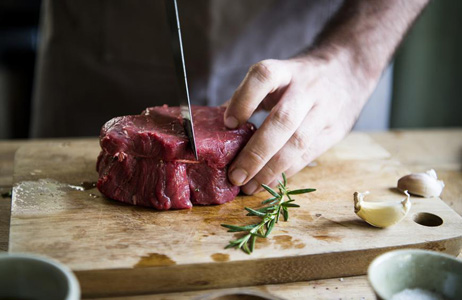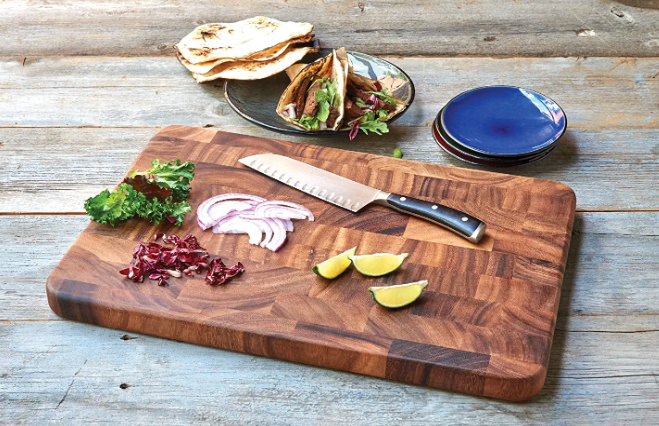How to Clean Cutting Board After Raw Meat

Dealing with a cutting board after cutting raw meat is never easy. When you’re cutting meat, you’re going to end up with bits and pieces of flesh, blood, fats, meat residues, etc, here and there. Even though we clean them regularly, micro bits remain on the board, which eventually stagnates and forms molds. Furthermore, if you use that same cutting board for something else, there remains a risk of cross-contamination. For this reason, it’s crucial to clean the cutting board carefully every time after handling raw meat.
However, we often tend to underrate the chopping boards’ cleaning process and think that giving it a rinse with soapy water is sufficient. However, that isn’t even half the work. In this article, we’re going to discuss the process of cleaning a chopping board after dealing with raw meat and how a few precautionary steps can reduce your workload. That being said, let’s begin!
Are you hurry?watch this video:
How to clean cutting board after raw meat step by step guide:
● Wipe it clean:
The first step in cleaning the cutting board is to remove any visible form of residue from the cutting board. Take a clean dishcloth and use it to clean the surface of the cutting board thoroughly. Use a lint-free cloth. Otherwise, there will be lint all over the board, which is an issue on its own. Please make sure no bits of meat are visible on the board once you wipe it. For this, we recommend using a plastic cutting board. Most plastic cutting boards for meat have a light color, making the small meat particles more visible.
● Disinfect the board:
Once the board is wiped clean, it’s time to disinfect the board. Cutting boards contain a lot of germs that cannot be cleaned by soap only. We recommend using bleach or Hydrogen Peroxide to disinfect.
If you’re using bleach, take two teaspoons of liquid bleach or bleaching powder in 500ml water and mix it thoroughly in a spray bottle. Spray the mixture on both sides of the cutting board and let it sit for a while. Afterward, wipe off any excess from the board with a clean piece of cloth or lint-free cloth
If you plan on using Hydrogen Peroxide, go for the 3% solution since it’s the safest. Mix one teaspoon of it in one cup of warm water. The mixture will fizzle up a bit. Then, use a sponge to apply it all over the board. Just like bleach, let it dry off and then wipe away any excess.
Both Hydrogen Peroxide and bleach are incredibly corrosive. Use adequate protection when working with them. Always wear safety gloves (price on amazon 19$) and make sure they don’t come in contact with your skin.
● Remove odor:
Sanitizing is a crucial part of the process. However, if your cutting board still has a funky, meaty smell, there might be some bits of germs remaining on it yet. It’s necessary to deal with the odor. Otherwise, more bacteria will grow in no time. Salt and vinegar are excellent natural odor repellants. They’re cheap and available in bulk, so you won’t have to worry about finding them either.
If you’re using salt, use a salt shaker to pour salt all over the board, leaving no space empty. After a few minutes, wipe the salt and give it a rinse. However, if you plan on using vinegar, make a solution of one-part vinegar per two parts water. Please put it in a spray bottle or wet a sponge with that solution and mix it thoroughly. Let it sit for 30 minutes and then go for the next step.
● Rinse and clean:
Now that we’ve dealt with the disinfection process, we have to rinse it clean. In a bucket, take a few tablespoons of detergent and water. Mix it thoroughly and use a sponge to apply it all over the cutting board. Make sure you spread the mixture on both sides, and no part is left dirty. Once the soap is applied, use running water to clean the board thoroughly. Wash the soap properly as dried-out soap is unhygienic.
● Dry out the board:
Drying is an essential part of cleaning any kitchen appliance. If it’s not dried entirely, the water will stagnate, causing odors and mold. The easiest way in this is to wipe the board clean first. Afterward, put it vertically on top of the dish rack and let it dry in the air. Make sure it doesn’t come in contact with dirty dishes or raw protein when it’s drying. Once it’s completely dry, store it carefully.
● Season the board:
If you have a plastic cutting board, you can ignore this process. However, if you own a wooden cutting board for meat, this process is a must. Wood is composed of cellulose, so its pores get open and susceptible to bacteria when it gets dry. Bacterias from meat can easily seep into the wooden board. Even the best wooden cutting boards for meat aren’t free from this problem. The easiest way to deal with this is by seasoning the board.
Read also: Best Wooden Cutting Board for Meat | Click Here
Seasoning means adding natural oils in small amounts to make sure the pores in the wood are closed. Take any crude oil and apply it on a lint-free cloth. Use the material to rub the oil all over the board. Then, let the board rest, and you’re good to go. Season the council once every week to make sure your board remains in pristine condition always.
How to Clean Wood Cutting Board After Raw Meat
The time-consuming process of scrubbing food out of wood can be annoying, but this particular dirty job is even more annoying when it comes to wood boards used for preparing meat. Raw meat is the worst culprit, as it can leave a sticky residue that may contain meat, blood, bacteria, and all sorts of nasties that could make you sick if not scrubbed off completely. Before you start cleaning the board, it is important that you use a strong Disinfectant.
Now, we will teach you how to clean wood cutting board after raw meat
Step 1: Disinfect
You will need to purchase a 3% solution of Hydrogen Peroxide at the pharmacy. It can be bought over the counter. A cup of warm water is all you need to mix it. If you want to wipe the stained area, use a cotton swab or piece of cotton cloth. Don’t touch it with your bare hands as it can sting. Just like before, let it airdry and then rinse it off.
Don’t you know that hydrogen peroxide is going to bubble up and fizz every time you pour it on the board? You don’t need to worry because this just means that the solution is doing its job, and killing the bacteria that is causing that icky smell. Remember to pour the solution on every time you cut meat on your board.
A bubbling noise can be heard with the use of the 3% Hydrogen Peroxide solution, but this is completely normal and is in no way detrimental to the wooden boards. In fact, this is actually a good sign because it means that the solution is trying to kill the bacteria. I can’t stress enough the importance of cleaning the boards with the 3% Hydrogen Peroxide solution after cutting meat on them.
Can’t wait for 3% Hydrogen Peroxide? Try using 2 teaspoons of chlorine bleach (make sure it says food grade!) in half-gallon of clear, warm water. Next, with a sponge, soak the board in the solution and wipe it clean with circular motions.
Step 2: Soap
For this task, I use a bit of soap and mix it in some water till it lathers. Then, I take a piece of cloth and dampen it in it. Next, I clean the wooden cutting board. This will completely clean the surface of the wooden board. Finally, I let it air-dry till further use.
Step 3: White Vinegar
The most effective way to get rid of the smell of raw meat is to clean your wooden board with a little white vinegar on both sides. White vinegar is strong enough to get rid of even the filthiest of stenches. The best part is that once it dries, its own smell completely evaporates away.
Step 4: Air Dry
You’ve just finished learning how to properly care for your wooden cutting board, but there’s one more thing that you must do. Allow it to dry in a horizontal position, so moisture doesn’t get trapped beneath its surface. And now you’ll never have to worry about properly cleaning your wooden cutting board after preparing raw meat.
Conclusion:
We love proteins. A well-cooked steak or a perfectly roasted chicken is worth dying for. However, raw proteins carry enough bacteria to cause a severe health hazard. When we’re using a chopping board, bacteria can easily get attached to our board and contaminate other food. So, it’s essential to clean the cutting board properly every time it comes in contact with the raw protein. In this article, we’ve discussed the process for cleaning cutting boards after using them to cut raw meat. We hope you find this article useful!


![Best Cutting Board Holder 2023 [Top 5 Picks]](https://kitchenapplince.com/wp-content/uploads/2021/11/Best-cutting-board-Holder-1.jpg)

